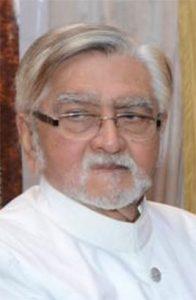M Ghazali Khan
A friend has shared a photograph on his Facebook showing two images of a small section of the 12th verse of Surah An-Nisa (4:12) in one of which, perhaps because of a typo, مِمَّا تَرَكْنَ has been misspelled as مِمَّا تَرَكْتم. The caption beneath the photograph reads, “See the difference between new and old print and share it too.” The initiator of the post also warns, “Not to share is no less than blasphemy. My duty was to inform you; rest is your choice.”
The gentleman is trying to imply some conspiracy hatched to distort the Holy Qur’an. There are no details of the publisher and the city or country where it has been published.
Photoshop has made morphing photographs very easy. Looking at the number and frequency of morphed images being circulated on social media, it is difficult to say whether the image in question is real or morphed. However, this is neither the first incident of this kind nor will it be the last. But the friend or friends who have shared it on their Facebooks and those who have uncovered this “conspiracy” should have, first and foremost, contacted the publisher or some responsible personality or institution in the city where the publisher happens to be and should have drawn their attention towards this mistake. Whatever be the truth behind this photograph the fact is that this unauthentic and unverified picture is being shared on Facebook and is being forwarded on internet, WhatsApp and Twitter.
This is just one example of how an effective and useful means of communication that should be used for learning and to educate the younger generation is thus instead being misused to spread baseless and fabricated stories and to earn virtues and rewards in the hereafter with just a few clicks on the keyboard. For example, the photographs and videos of Ka’ba and the tomb of Prophet Muhammad (PBUH) are being posted frequently with captions, “Only the unfortunate ones will not share this.” Or the name of the Prophet (PBUH) written on a beautiful bouquet of flowers with a question, “Is there any heart in which there is no love for this name?” Usually such posts also carry a warning: “When you think of sharing this, the devil will stop you from doing so.”
After almost every natural disaster in any part of the world, where there happens to be some Muslim population, the picture of a sole surviving mosque in, Banda, Aceh in Indonesia in the Tsunami of 2014, resurfaces on social media and is attributed to the new calamity hit city.
Despite the fact that no one is allowed to enter the inclosure of Prophet’s Tomb, let alone being allowed to take photographs, it would be hard to imagine that any Muslim using social media will not have seen the pictures of the grave of the Prophet (PBUH).
There is a long list of photoshopped pictures being circulated on social media with ever fascinating stories with them. After every few weeks or months when the zeal of some faithful arouses and when he feels like earning effortless rewards for a good deed he picks one of these photographs and starts posting on his Facebook. One fails to understand what purpose do these morphed photos and baseless stories serve and how do they benefit anyone? Does one think that the Holy Qur’an and the Hadiths of the Prophet (PBUH) are not enough to prove the veracity of Islam?
What one finds amazing is that these stories and photos are not being posted by immature youths but even some well-educated and mature people are also involved in this useless and time wasting exercise. For example, a couple of months ago a gentleman posted a photograph of the inner view of a compartment of a train in which a small place was shown to have been reserved for Muslims to pray. It was perhaps a photograph of a train in a Muslim country but this was not shown or explained as such. Instead the caption claimed that the facility was provided on a British train. Along with that governments of the Muslim countries were told to be ashamed of themselves for not making such arrangements in their trains. Interestingly the person who had shared and forwarded it is an educated and well experienced man who lives in London.
The other and even more interesting story that was shared on various Facebooks was circulated with a video clip. It showed a mosque in some European country where some tourists, and may be some locals, are seen taking photographs and making videos while a call for prayers is being heard coming from inside the mosque that surprises everyone. However, the story about the video clip said that few years ago the government (it did not say which government and in which city) had locked the mosque imposing a ban on prayers in the mosque. The video clip also claimed, “One day, call for prayers started coming from inside the mosque that surprised passers-by making videos of the scene.”
Perhaps even greater fitnah (mischief) for Muslims is the misuse of availability of the facility of making videos of one’s own speeches and uploading them on Youtube. This useful medium is being used by all kinds of people for various good and bad purposes. Needless to say that some Muslim scholars are using it to spread the true message of Islam and to negate the toxic propaganda of Islamophobes against Islam and Muslims. But there are also some mischievous elements who are using this medium to create hatred between various Muslim sects and to declare each other as kafirs.
Usually these are the organisations like Daesh and Alqaida that are described as takfeeri but if you were to listen to the hate filled and aggressive speeches of “YouTube ulema”, you will come to the conclusion that each Muslim sect is takfeeri. And if one were to accept their arguments then one will have to believe that there is no Muslim left on the face of earth. Instead of using their skills to do further research and spread true knowledge about Islam, these guys are digging up forgotten and centuries old books, that had been gathering dust in libraries and archives, to use toxic arguments from them and are busy in increasing sectarian hatred and differences and thus are becoming a fitnah in themselves.
Only if, after recording, these hate filled, self-admiring, self-praising, foul-mouthed, uncourteous, impolite and egoist individuals and embodiments of bad manners, had watched and listened to their videos and examined their poisonous and repulsive speeches in the light of the teachings of the Prophet (PBUH) and asked themselves if their behaviour is in accordance with his Sunnah and if this is how a preacher should act? Except provoking one’s audience, can such a bad language serve any other purpose? Such is the level of their “piety” and “knowledge” that in a TV channel of a particular sect when the interviewer asked a preacher, known for his foul mouthing rhetorics , “Sir, looking at your busy schedule, attendance and lectures in public meetings and long journeys, one wonders how you manage to get time to study?” With a broad smile on his face, reflecting a sense of pride, the gentleman replied, “Shall I tell you the truth? I don’t study.” Even such a culpable answer of stupidity was responded to by his blind followers with a great admiration and appreciation (because he is already so full of God-given knowledge that he doesn’t need to study) and by the chants of, “Subhan Allah, Subhan Allah!” The fact is that for the type of speeches that this “scholar” makes he surely does not need to study.
Congratulating himself for his toxic and vicious attacks on others, another YouTube preacher, belonging to an opposing sect, exclaimed, “The ones I treat writhe in pain.” Never ever have I heard this man being polite and saying what he says in a civilised manner. Instead of attracting and convincing anyone he probably repulses away everyone he wants to send his message to. His self-praise shows that he knows how impolite he is but only those whom Allah guides reflect upon their weaknesses and reform themselves.
A third and pretty effective facility provided by social media are the discussion groups. These yahoo and google groups serve as electronic chaupals. These groups are run and owned by moderators who disapprove or approve and publish the messages sent to them by the members/ subscribers through emails. Approved messages are sent to all the subscribers of a group who express their views on these posts or ignore them.
The drawback of these groups, however, is that unlike a gathering in which humans are physically present and can see each other, here they participate from far away and distant lands thousands of miles away in different corners of the world. The eye contact or Aankh ka lihaz, as we call it in Urdu, that is necessary to keep any social gathering civilised, is absent here. Some self-righteous and uncouth elements take full advantage of it and do not hesitate in passing extremely offensive and provocative remarks that, in any civilised gathering they would only use at their own risk. Although as time passes generally members gather pretty good idea about each other’s backgrounds and views, some mischievous elements use fake identities and fake names and feel free in posting unpleasant comments.
Such groups are being used by various lobbies and interest groups. Indian Muslims too have various groups some of the most prominent and active of which are: AMUnetwork@yahoogroups, Worldofaligs@yahoogroups, Aligarhforum@yahoogroups, Aligarhnetwork@yahoogroups, Indianmuslims@yahoogroups, Muslimindians@yahoogroups and NRIndians@googlegropus.




All of them have played pretty beneficial role in providing the facility to educated Indian Muslims to express their views on a variety of issues and to know and contact each other. However, except Aligarh Forum, World of Aligs and AMU Network that have also provided scholarships to poor and deserving Muslim students, all of them are nothing more than talking forums or as the famous Persian saying goes, “Nashistand, guftand, barkhastand” ie “they gathered, they talked and they went away”.
Aligarh Forum is run by an AMU alumni and Washington based scientist Dr Razi Raziuddin. Through this group he has raised funds, coordinated and arranged fees for poor students for various courses, including professional courses, and also arranges coaching for various job related exams. It is said that one of Dr Razi’s new projects is building a degree college in Azamgarh, where he originally comes from.
World of Aligs is run by senior surgeon Dr Mohsin Raza, President of AMU Students Union in 1965, a former lecturer at AMU’s JN Medical College who has also worked in Iran and Oman. Dr Raza has been arranging scholarships for poor students since 1971. Last year World of Aligs gave 130 scholarships three of which were for three IIT students, 48 were for madrasa graduates pursuing various courses at AMU, and lodging and food fees for one year for 42 other boys and girls in various courses. Dr Raza is also active in a cancer awareness campaign, specially breast cancer among women, and has held various camps around Aligarh.
AMU Network is run by Dr Shaheer Khan, originally from Shahjahnpur, and Afzal Usmani, originally from Azamgarh, both AMU alumni and US based scientists.
On all of these groups issues ranging from international politics to various problems facing the community are freely discussed. While others have kept themselves away from sectarian and theological discussions, NRIndians, has not been able to protect itself from the bitterness, ill feelings and sourness that sectarian discussions often bring. This is run by Mr Pasha Patel based in Saudi Arabia. Despite the fact that various prominent Indian Muslims including former minister Salman Khurshid, editor Milli Gazette Zafrul Islam Khan, President of All India Muslim Majlis-e-Mushawarat Naved Hamid and Kamal Farooqui subscribe to this and despite being the largest and probably most active group, the identity of its moderator, Pasha Patel, remains a mystery. Except, perhaps, very few no one seems to know about him. Some even think that Pasha Patel is not his real name.
Let it be said that a comparison of the usefulness and vibrancy of these groups was not my intention. This has come up as a passing reference. The main purpose was to remind those elders who keep worried about the possible misuse of internet by their children and the danger of them coming into contact with wrong and mischievous elements but do the older and intelligent people ever reflect upon how intentionally or unintentionally as well as carelessly they make the use of this means of communication, to say the least.
Urdu version of this article appeared in daily Jadid Khabar, Delhi, 23 May 2016 and Asia Times

